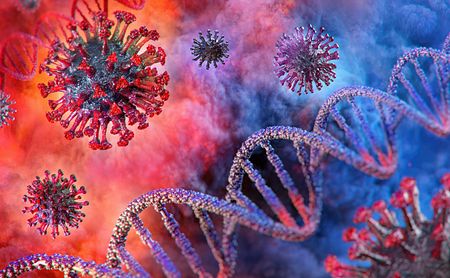Dormant Viruses May Cause Parkinson’s

Dormant viruses lying hidden in the nervous system can give rise to Parkinson’s disease, according to a newly-published biological model.
The article describing this finding, “How microcompetition with latent viruses can cause α synuclein aggregation, mitochondrial dysfunction, and eventually Parkinson’s disease,” was published in the Journal of NeuroVirology.
Malfunctioning mitochondria — structures within cells that provide energy — and misfolded clumps of the alpha-synuclein protein are two hallmarks of Parkinson’s; but precisely what causes them remains unknown.
A new theory called the “microcompetition model” suggests that dormant (latent) viruses hidden within our cells compete with native genes for access to proteins involved in turning DNA into proteins.
Latent viruses usually cause no symptoms, thereby evading any suspicion that a virus is present. Examples of these include the Epstein-Barr virus, cytomegalovirus, herpes simplex virus 1, HIV, and the varicella zoster virus.
When these viruses infect a person, the immune system limits the degree to which they can multiply. As a person ages, however, the immune system grows less efficient, slowly allowing the latent viruses to copy themselves.
Other factors, often related to aging, such as certain medications, surgery, chemotherapy, radiation, and stress, also contribute to the weakening of the immune system.
As the virus multiplies, it forces increasing competition with cellular genes over the cell’s resources.
In this model, Parkinson’s risk increases when competition for cellular resources contributes to mitochondrial dysfunction and makes neurons and immune cells less able to function efficiently.
The main protein complex predicted to be hijacked by latent viruses is called the GABP p300/cbp complex, formed of the three proteins GABP, p300, and cbp. Of these, GABP is important for making several proteins involved in transport across the mitochondrial membrane.
Two of these proteins — TIM23 and TOM20 — form important and non-redundant parts of the cellular machinery responsible for importing precursor proteins into the mitochondria. (A precursor protein is an inactive protein that can be turned into an active form through specific modifications inside the cell.)
Past studies have linked reductions in TIM23 to Parkinson’s development.
TIM23 and TOM20 import several precursor proteins needed for the electron transport chain (ETC) into the mitochondria. The ETC is a coordinated series of biochemical reactions that generate the overwhelming majority of the cell’s energy.
Disruptions in the ETC cause reactive oxygen species — a chemically reactive form of oxygen — to accumulate, further damaging the mitochondria and other cellular components.
The microcompetition model also predicts that less available GABP p300/cbp complex causes misfolded alpha-synuclein proteins to aggregate by slowing the cell’s rate of protein recycling, a process called autophagy.
In a healthy setting, autophagy keeps the number of misfolded alpha-synuclein low, preventing them from linking together and triggering the growth of toxic clumps.
Prior research suggests that these clumps form when either the alpha-synuclein gene is inappropriately duplicated or when autophagy slows down.
Reinforcing GABP’s prior effect on mitochondria, toxic alpha-synuclein clumps are implicated in causing mitochondrial dysfunction by blocking TOM20 from acting.
A drop in autophagy poses a particular challenge for nerve cells, as these generally do not duplicate, meaning that a nerve cell with too much damage cannot be replaced by a new, healthy cell.
GABP also appears to regulate production of one of the main autophagy regulators, a protein called beclin-1, further reinforcing the idea of viruses increasing Parkinson’s risk by competing for GABP.
The microcompetition model supports the “multiple hit hypothesis” of Parkinson’s development, which suggests that Parkinson’s arises from multiple causes rather than just one.
“We propose that a reduction in the availability of the GABP p300/cbp complex, as a result of sequestering the transcription complex by a latent virus that infects the nervous system, can cause [Parkinson’s] in two different but related ways: mitochondrial dysfunction driven by an impairment of the protein import machinery and [alpha-synuclein] accumulation due to reduced autophagy,” the researchers concluded.






